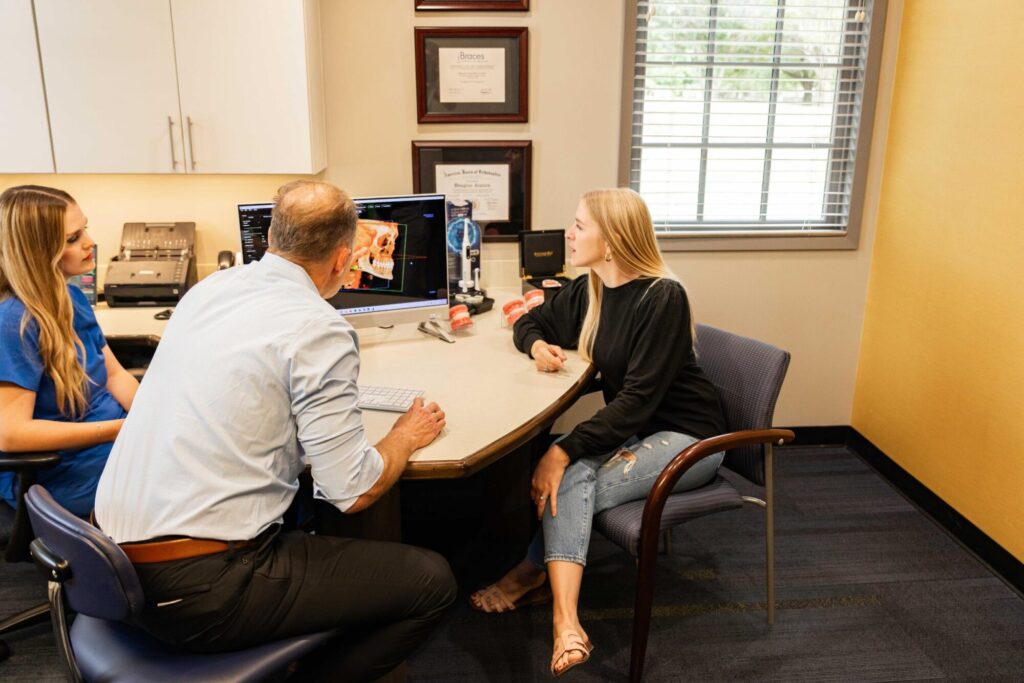Most adults don’t expect to find themselves back in an orthodontist’s chair. It’s becoming more common than you’d think in McKinney and across the world. People are showing up for orthodontic treatment after years of putting it off, finally ready to fix the crowding, the bite issues, or the smile they have never really liked.
Dr. Jensen sees it all the time at Jensen Orthodontics. Some patients wore braces decades ago, and their teeth shifted. Others never had the chance. Whatever brought them in, they usually say the same thing, like, “I’ve wanted to do this for a while.” Now feels like the right time.
Teeth Keep Moving, Even When You’re Grown
Your jaw doesn’t stay the same as you age. Bone density changes and habits shift. You might grind your teeth more than you used to, or you might clench your jaw during stressful weeks. Little things add up. Over time, your smile might not look or feel the way it used to.
This is one of the most common reasons adults seek orthodontic treatment. Your teeth aren’t just “a little crooked.” They’ve been drifting, crowding, and twisting. You notice it in photos or when you try to floss. Or when your bite just doesn’t line up anymore and you’re not sure why. Braces or aligners can correct that before it becomes a bigger issue. Left alone, misalignment tends to get worse, not better.
Invisalign vs. Braces
One of the first questions people usually ask is either “Do I have to get braces, or can I go with Invisalign?” Here’s the breakdown of the options in real terms:
Invisalign
Nearly invisible
Removable for eating and brushing
Great for mild to moderate alignment issues
Needs serious consistency and you have to wear them 20+ hours a day or they don’t work
Metal Braces
- Fixed in place (no forgetting to put them back in)
- Still the best option for more complex shifts
- Smaller and smoother than they were years ago
- Can be customized with clear or tooth-colored brackets if you want a more low-key look
Dr. Jensen will walk you through what’s realistic based on your bite, not just what looks good on paper. For some adults, Invisalign is perfect. For others, traditional braces are the better long-term move.
What’s Bothering You?
You might say it’s just cosmetic, but take a second look. Some adults come in saying they just want their smile to look better. Once they’re evaluated, it turns out their bite is doing more harm than they thought. Here’s what else could be going on:
- Chronic jaw tension
- Uneven tooth wear
- Gum recession from crowding
- Headaches caused by bite misalignment
- Difficulty flossing or brushing between teeth
Sometimes fixing your smile does more than make you like photos again. It makes life easier.
What Treatment Looks Like
This isn’t a school schedule. You’ve got responsibilities, routines, and not a lot of extra time. Orthodontic care for adults has to work around that, not the other way around.
Treatment is mapped out with your life in mind. Appointments are short and spaced out. If you’re using aligners, you’ll usually get multiple sets at once, so you’re not constantly coming in. If you’re in braces, the adjustments are straightforward and efficient.
The first week or two might feel strange, but that doesn’t last long. Most people settle into the routine quickly and start noticing the shift before they even realize it’s become normal.
Here’s What You Should Know Going In
Let’s cover a few of the things most adults ask during the first visit:
- Treatment times vary. On average, you’re looking at 12 to 24 months, depending on your case.
- Costs are manageable. Most patients can set up monthly payment plans. Insurance sometimes covers part of it, especially if the treatment is medically necessary.
- You don’t have to decide on the spot. Consults are for learning your options, not locking you into anything.
Everyday Life with Braces or Aligners
The beginning always takes a little getting used to. Your teeth feel different. Your mouth is adjusting. Whether you’re in aligners or traditional braces, the first week or two is when most of the changes happen. Here’s what makes that phase easier:
- Stick to softer foods while your mouth settles
- Use orthodontic wax if anything starts to rub
- Set a reminder to pop your aligners back in after meals
- Keep a toothbrush and flossers handy so you’re not scrambling mid-day
You might talk a little differently at first. Certain foods might be off the table for a bit. Even brushing feels more involved. It doesn’t take long before this stuff becomes part of your routine. What felt awkward in the beginning usually fades fast once your mouth adjusts and you start seeing things shift into place.
Long-Term Results That Stick
Finishing treatment is only part of the picture. Keeping your results in place comes down to wearing your retainer. It doesn’t have to be a big deal, but it does have to be consistent.
Retainers stop your teeth from drifting and undoing all the progress you just made. With regular wear and quick check-ins, your smile stays right where it should. No surprises later, just maintenance that works.
A lot of adults choose treatment because they’re tired of the slow, quiet shifting. They want something reliable. Braces and aligners give them a way to move forward without the guesswork.
When You’re Ready, We’re Here
You don’t need to have it all figured out. If something’s been bothering you, or you’re ready to finally fix what’s been holding your smile back, Dr. Jensen can help. Our McKinney office at Jensen Orthodontics offers honest insight and a straightforward next step if you decide it’s time. Give the office a call when you’re ready to schedule your consultation.



